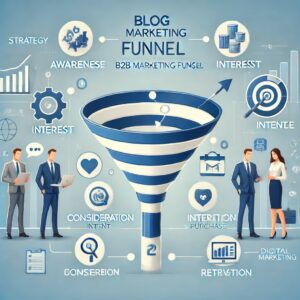
Mastering the B2B Marketing Funnel: A Comprehensive Guide
The B2B marketing funnel is a crucial concept for businesses aiming to convert prospects into loyal customers. Understanding each stage of the funnel and implementing effective strategies can significantly enhance your marketing efforts and drive sustainable growth. This blog post explores the B2B marketing funnel in detail, offering actionable insights and best practices to optimize each stage.
What is a B2B Marketing Funnel?
A B2B marketing funnel represents the journey that potential customers take from the initial awareness of your product or service to the final purchase and beyond. It consists of several stages, each designed to move prospects closer to becoming paying customers. The funnel helps marketers understand where prospects are in their buying journey and tailor their strategies accordingly.
Stages of the B2B Marketing Funnel
1. Awareness
At this stage, potential customers become aware of your business and its offerings. The goal is to attract attention and generate interest.
Strategies:
-
- Content Marketing: Create valuable content such as blog posts, whitepapers, and videos to attract and educate your target audience.
- SEO: Optimize your website for search engines to increase visibility and attract organic traffic.
- Social Media Marketing: Use social media platforms to share content and engage with your audience.
- Paid Advertising: Invest in paid ads to reach a broader audience and drive traffic to your website.
2. Interest
Once prospects are aware of your business, the next step is to nurture their interest and provide more information about your products or services.
Strategies:
-
- Email Marketing: Send targeted email campaigns with relevant content and offers.
- Webinars and Events: Host webinars and events to showcase your expertise and build relationships with potential customers.
- Retargeting Ads: Use retargeting ads to stay top-of-mind and remind prospects of your offerings.
3. Consideration
At this stage, prospects are evaluating your product or service against competitors. The goal is to highlight your unique value proposition and convince them of your solution's superiority.
Strategies:
-
- Case Studies and Testimonials: Share success stories and testimonials from satisfied customers to build credibility.
- Product Demos: Offer live demos or free trials to allow prospects to experience your product firsthand.
- Detailed Content: Provide in-depth guides, comparison charts, and FAQs to address potential questions and concerns.
4. Intent
Prospects at this stage have shown a clear interest in your product and are close to making a purchase decision. The goal is to facilitate the decision-making process and encourage them to take action.
Strategies:
-
- Personalized Outreach: Have your sales team reach out with personalized messages and offers.
- Limited-Time Offers: Create urgency with limited-time discounts or special promotions.
- Clear CTAs: Ensure your calls-to-action (CTAs) are clear and compelling, guiding prospects towards the next step.
5. Purchase
This is the stage where the prospect becomes a customer by making a purchase. The goal is to ensure a smooth and positive buying experience.
Strategies:
-
- Seamless Checkout Process: Make the purchasing process as easy and frictionless as possible.
- Customer Support: Provide excellent customer support to address any issues or questions.
- Follow-Up: Send a thank-you email and offer onboarding assistance to new customers.
6. Retention
The final stage focuses on retaining customers and encouraging repeat business. The goal is to build long-term relationships and maximize customer lifetime value.
Strategies:
-
- Customer Success: Implement a customer success program to ensure customers achieve their desired outcomes.
- Loyalty Programs: Offer loyalty programs or incentives for repeat purchases.
- Regular Engagement: Maintain regular communication through newsletters, updates, and personalized offers.
Best Practices for Optimizing Your B2B Marketing Funnel
- Align Sales and Marketing
Ensure your sales and marketing teams are aligned and working towards common goals. Regular communication and collaboration between these teams can lead to more effective lead generation and conversion strategies. - Use Data-Driven Insights
Leverage data and analytics to gain insights into your marketing funnel's performance. Monitor key metrics such as conversion rates, lead quality, and customer acquisition cost to identify areas for improvement. - Implement Marketing Automation
Use marketing automation tools to streamline your lead nurturing process. Automated email sequences, lead scoring, and CRM integration can help you manage leads more efficiently and personalize your outreach. - Personalize Your Approach
Personalization is key to building relationships with prospects and customers. Use data to tailor your messages and offers based on the prospect's behavior, preferences, and stage in the marketing funnel. - Continuously Test and Optimize
Regularly test different strategies and tactics to identify what works best for your business. A/B testing, feedback loops, and performance analysis can help you refine your approach and achieve better results.
Conclusion
Mastering the B2B marketing funnel is essential for converting prospects into loyal customers and driving sustainable growth. By understanding the stages of the funnel and implementing effective strategies at each stage, you can optimize your marketing efforts and achieve greater success.
For more insights and personalized strategies on optimizing your B2B marketing funnel, consider booking a free strategy call with MyGrowthHack. Together, we can help you achieve your business goals and unlock your full potential.


